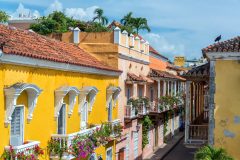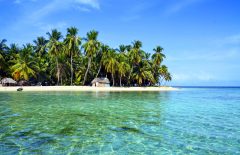Group - Classic
Chachalaca: Colombia’s Colonial and Coffee Culture
14 days from £4,370pp
(based on two people sharing & excluding flights)
Itinerary
 Map
Map
UK clients depart, arriving Bogotá, Colombia, in the evening or the following morning.
Those of you arriving on an international flight this evening will be met at the airport and escorted to your hotel so you can rest before the tour officially starts the next morning.
Days 1-2
City tour, including a visit to the Gold Museum.
If arriving on an overnight international flight will be met at the airport early in the morning and escorted to your hotel in a commercial and residential quarter in the popular north of the city where your room will be waiting for you to rest for a few hours.
Bogotá is a city of sparkling prosperity and creative innovation, but also home to people living on the margins of society, and everything in between. It’s awash with splendid colonial churches, fascinating museums, futuristic architecture and lively universities. Its population is diverse and engaging and its cultural life vibrant.
You have time to relax, get accustomed to the altitude, get to know your fellow travellers and familiarise yourself with your surroundings. A short hop from the hotel is the up and coming quarter Usaquén, once a town in its own right but now absorbed into the capital with a vivacious flea market on Sundays.
We take you on a guided exploration of the city with a walking tour of the historic core, the colonial Candelaria district, crammed with baroque churches, museums and graceful Spanish-style buildings with intricate balconies, shuttered windows and huge wooden doors. You head to the historic centre and the vast central Plaza de Bolivar, framed by the imposing Cathedral and Congress building. Explore the steep colonial streets ultimately reaching the Gold Museum. This is an extraordinary, well-displayed collection of pre-Columbian artefacts housing more than 34,000 gold pieces.
Later there’s an ascent of the mountain towering over Bogotá, with a white church at its peak. From there, at a heady 3,152m above sea level, there are splendid views. There’s a steep path up to the top but you won’t have to climb: a cable-car and funicular railway station whizz you to the top.

Stay at -
The Artisan DC Hotel
Day 3
Drive to Villa de Leyva via Zipaquirá salt cathedral.
3-4 hours’ drive from Bogotá, Villa de Leyva is a well-preserved colonial highland town steeped in history, popular among Colombian and foreign visitors alike and busy at weekends. En route you make a stop at Zipaquirá, home to a centuries-old salt mine, which is still functioning. Nearly 200m beneath the earth are two extraordinary salt cathedrals, their vast pillars and walls made from glistening salt. There are also 14 stations of the cross sculpted by various Colombian artists.
Villa de Leyva is a small Spanish-style town founded in 1572 which has been home to many important politicians, artists and wealthy families of the colonial period. The town is extremely well preserved. The enormous plaza mayor (the largest in Colombia) is flanked on all sides by red-tiled, whitewashed houses and most of the streets are cobbled. You can wander around a leisurely place absorbing the atmosphere, browsing in the handicraft shops and popping in to any of the small museums.
This region of Boyacá was once submerged under the sea and a large number of marine fossils can be seen in the area. The scenery of the immediate surrounding countryside is somewhat Mediterranean in appearance and olives, oranges and other citrus fruits are cultivated there. However, nearby are both near-desert, arid landscapes and chilly high altitude puna blanketed in rough grassland.

Stay at -
Posada de San Antonio
Day 4
Guided visit to the varied highlights of the surrounding area.
Today you visit El Infiernito, a pre-Columbian Muisca indian site at the outskirts of Villa de Leyva. It is composed of several earthworks surrounding a setting of upright standing stones. The site was a centre of religious ceremonies and spiritual purification rites, and also served as a rudimentary astronomical observatory.
You also visit the ‘Ecce Homo’ Dominican convent, constructed in the XVII century, which has experienced a chequered history of military occupation, abandonment and restoration. You also get to view the fossil of a reptile revealed just outside the town which is reckoned to be more than 150 million years old. Contrasting with the colonial baroque style is the Gaudiesque Casa Terracota which looks a bit like the cosy, rustic home of a hobbit. As its name suggests it is virtually completely constructed and furnished with locally made terracotta ceramic tiles, including mosaics and an ingenious use of light.

Stay at -
Posada de San Antonio
Day 5
Fly to Armenia in the coffee region.
You are driven back to Bogotá via the Boyacá Bridge, where Simon Bolívar and his troops won the most important battle against the Spanish, sealing Colombia’s independence. There’s also a stop at Laguna Guatavita, an emerald green lake filling a crater hidden below steep cliffs in a tightly forested nature reserve. This lake pinpoints the origin of the legend of El Dorado, triggering many subsequent ill-fated quests for gold.
From Bogotá airport you fly to Armenia in the famous coffee region, centred on the western slopes of the Cordillera Central. This green and fertile area has a pleasant climate, and lovely bucolic scenery with a mountainous, lush, green landscape of shiny coffee bushes interspersed with enormous bamboo jungles and banana plants. You’ll be staying at traditionally styled countryside accommodation in this photogenic region.

Day 6
Guided visit to a coffee farm.
Many working fincas (coffee farms) have embraced tourism and welcome visitors onto their plantations to learn all about the coffee-growing process. It is particularly interesting to visit during the harvests (April to May, October to December) when the farms are a hive of activity. You visit one of the region’s estates and learn about the intricacies of coffee production, from the picking of the coffee cherries to the various stages of processing, sorting, grading, roasting and the final brewing of the beans.

Day 7
Guided day trip to Valle de Cocora, Salento and Filandia.
You take a guided day trip out to Valle de Cocora, a beautiful nature reserve which is home to the wax palm, Colombia’s national tree and the only palm which grows above 3,000m. There’s a well-marked path up the valley to look out over the mountains’ verdant foothills, and the cultivated patchwork of fields made up of a dozen shades of green.
On the way back to Armenia we visit the to traditional Colombian village Salento, its houses adorned with balconies bursting with flowers, and with wonderful views of the Cordillera Central emerging from behind elegant colonial and bahareque (traditional mud and wood intertwined) buildings. It still has a villagey ambiance but is a popular weekend destination for Colombians these days and here you can browse a number of artisan craft shops.
You also make a stop in Filandia, one of the most quintessential villages of the coffee region where the window frames, doors and balconies are painted in bold paint-box bright primary colours.

Day 8
Travel from Armenia to Medellín by road.
Medellín, the capital of Antioquia department, has a year-round temperate climate, which explains why it is also known as the ‘City of Eternal Spring’. Its population is about 3 million, which makes it the second-largest city in the country. We are delighted to be able to include a visit on our itinerary as we are sure you’ll be captivated.
Medellín has left behind its somewhat dodgy reputation for newfound celebrity as a dynamic cultural and gastronomical centre. This exciting city exudes youthful innovation and enthusiasm hosting numerous internationally recognised events such as the August Flower Fair and the International Poetry Festival. You’ll find well-managed parks and plazas dotted with sculptures, while the whole city is serenaded by music.
Stay at -
Park 10
Day 9
Guided city tour of Medellín.
Explore downtown Medellín and the historical centre with its soundtrack of traditional Guasca music, performed by musicians in Parque Berrio. Stroll through the hustle and bustle of downtown to Plaza de las Esculpturas which hosts an exhibition of the work of Colombian artist Fernando Botero, whose voluptuous sculptures have become a landmark of the city.
Take the Metrocable service up to Santo Domingo, in the past a notorious area ruled by gangs but where now the focal point is the library, Parque Biblioteca, featuring thousands of books, which was opened by the King and Queen of Spain in 2007. The cable-car system was constructed to make the inner city more accessible to people from the outskirts. While enjoying bird’s-eye views over the sprawling residential and commercial quarters you learn more about the transformation of Medellin into a fascinating melting pot of cultures with some of the friendliest and warmest people in Latin America.

Stay at -
Park 10
Day 10
Guided visit to El Peñol and Guatapé.
You’ll travel by road through the eastern highlands of Antioquia. The Peñol Boulder is one of the most spectacular natural features in the landscapes surrounding Medellín. This striking 200m high sugar-loaf shaped granite monolith can be climbed via a 740-step pathway. If you choose to ascend this way your efforts will be rewarded with breathtaking views over the picturesque countryside where bright green, crinkly mountains are studded by spidery blue lakes.
You also make a stop at the tranquil village Guatapé, a lakeside town with a pleasantly warm climate. It is famous for its Greco-Roman church and the vivid paintings, called zócalos, featuring local families and historical events which adorn the base of the Technicolor, paint-box-bright houses. Here you have time to explore independently, perhaps savouring a traditional Colombian lunch on the lake shore, taking a boat ride on the placid waters or just strolling through the streets, which are quiet except at weekends when they are thronged by families from Medellín.

Stay at -
Park 10
Day 11
Fly to Cartagena on the Caribbean coast.
The country’s most exotic and atmospheric colonial city, Cartagena, was founded in 1533. It quickly blossomed to become the main Spanish port in the Caribbean. Treasure plundered from native indians was stored there until galleons could ship it back to Spain, and the city became a tempting target for pirates. In order to protect their booty, the Spanish colonists constructed an elaborate system of ramparts which still encircle the town.
Today, while Cartagena has expanded dramatically, the walled centre has changed very little, preserving an uninterrupted display of 16th and 17th-century Spanish architecture. Here you can enjoy the shade provided by the buildings in the labyrinthine cobbled streets, and explore the many monasteries, palaces, churches, plazas and imposing mansions where the overhanging balconies are heavy with flowers.

Stay at -
Bovedas de Santa Clara
Day 12
Guided city tour of Cartagena.
The city, now a UNESCO World Heritage Site, is an eclectic and seductive mix of Caribbean and African influences producing a vibrant street life, with fruit stalls lining the roads and pulsating rhythms emerging from cars and houses. Your guided tour of the historic walled city, the forts and battlements will help you soak up the atmosphere of this seductive city, possibly the most evocative and romantic on the continent.

Stay at -
Bovedas de Santa Clara
Day 13
Day at leisure in Cartagena.
Now you enjoy a day at leisure, free further to explore the streets, visit the famous fort, have a meal in one of the many fantastic al fresco restaurants or even travel further afield and take a speedboat to spend the day on the coral, palm-kissed beaches of the nearby Rosario Islands.

Stay at -
Bovedas de Santa Clara
Day 14
Transfer to airport for international flight.
UK clients arrive home the following day.
Outline itinerary
UK clients depart, arriving Bogotá, Colombia, in the evening or the following morning.
Days 1-2
City tour, including a visit to the Gold Museum.
Day 3
Drive to Villa de Leyva via Zipaquirá salt cathedral.
Day 4
Guided visit to the varied highlights of the surrounding area.
Day 5
Fly to Armenia in the coffee region.
Day 6
Guided visit to a coffee farm.
Day 7
Guided day trip to Valle de Cocora, Salento and Filandia.
Day 8
Travel from Armenia to Medellín by road.
Day 9
Guided city tour of Medellín.
Day 10
Guided visit to El Peñol and Guatapé.
Day 11
Fly to Cartagena on the Caribbean coast.
Day 12
Guided city tour of Cartagena.
Day 13
Day at leisure in Cartagena.
Day 14
Transfer to airport for international flight.
UK clients arrive home the following day.
Inspired by this trip
Our exciting range of articles on Latin America explore everything from iconic destinations and lesser-known cultural gems to delicious traditional recipes. You’ll also find exclusive travel tips, first-hand client reviews and the chance to get your personal questions answered by our travel experts.
Papagaio
Your edit for Latin American inspiration
Our exciting range of articles on Latin America explore everything from iconic destinations and lesser-known cultural gems to delicious traditional recipes. You’ll also find exclusive travel tips, first-hand client reviews and the chance to get your personal questions answered by our travel experts.
View Extraordinary Inspiration






































